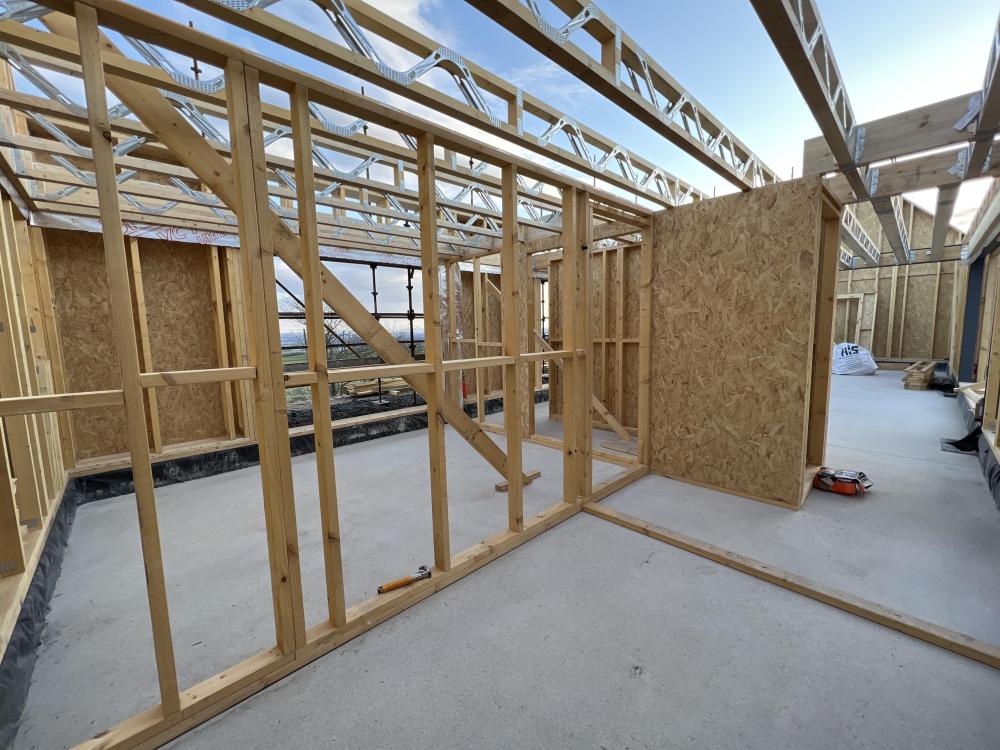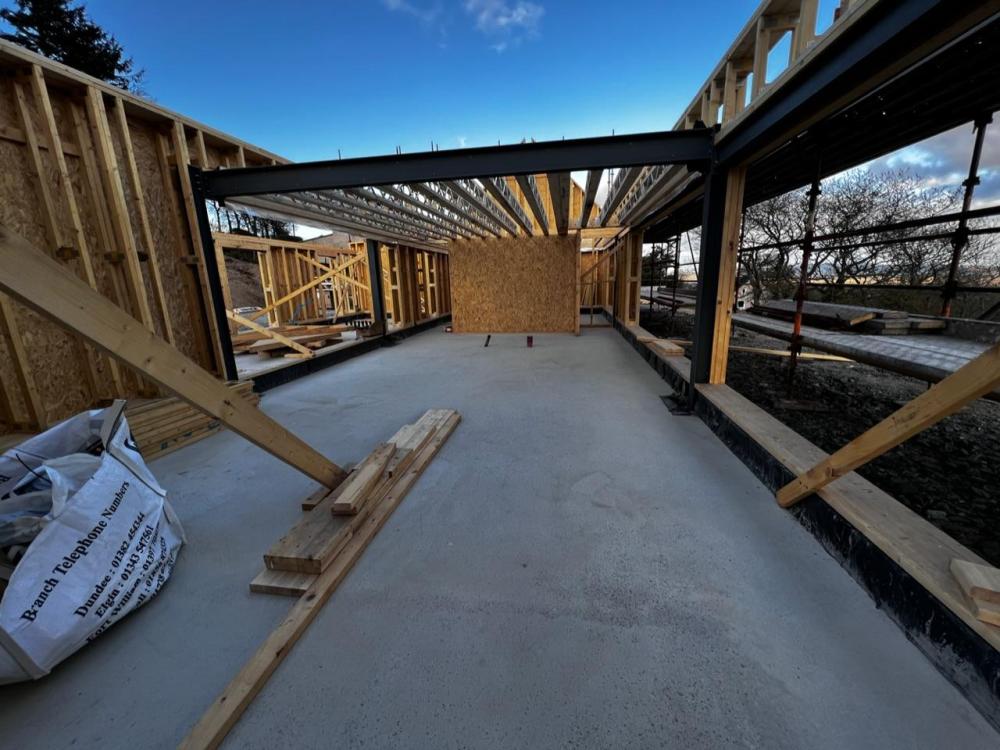Leaderboard
Popular Content
Showing content with the highest reputation on 04/25/23 in all areas
-
3 points
-
Mine is only 2 leg, supported from the house but with spacers on the fixing bolts at the house end and set to a very slight fall away from the house to drain rainwater off the outer edge.2 points
-
Yep It can be a real issue We have to crane our boards in on some of the larger job So they are often there for months before we get near them with plaster Mainly sound block boards We normally use two coats of SBR 3-1 One of the coats the day before if possible2 points
-
Here's a bit of a gash suggestion. Fill the bath and cut and scrape out all the existing grout and silicone in place. Empty the bath. Take off the bath side cover. Cut battens to the right size for the width and length of the bath and push up from below as a dry fit. Make vertical supports to keep it pushed up against the base of the bath. These will ensure a tight fit. Next remove the dry fit batten and cover it in CT1 to seal the gap from below. Really heap it on there. Then push it up from below and wedge it there with the pre cut timbers. Put in a few screws to hold them in place if you can. Fill the bath. Apply as much CT1 as you can from above to meet that pushed up from below. Silicone later on. Beware it'll be tricky to put in the battens and potentially very messy with the CT1. It might get you through to a proper job when you can retile.2 points
-
Site tidying up: every day at least one hour. Nobody else is going to give a stuff Site security: every day something. Nobody else is going to give a stuff Site admin: every day something. Nobody else is going to give a stuff VAT return: every day something . Nobody else is going to give a stuff Catching dropped bollocks. Every single damn day. Nobody else is going to give a stuff Waste disposal. Most days. Nobody else is going to give a stuff Planning, re-planning, re-re-planning. Nobody else is going to give a stuff Talking to tradesfolk - listening - watching : being a good customer. They do give a stuff.2 points
-
1 point
-
PVA once applied and dried if it gets wet will start to loose adhesion, SBR doesn’t so it’s a better choice1 point
-
Very true - in fact the S curve is the pattern of everything BUT (could have used AND but I cannot be bothered) the S-curve is for a single technology. What people don't get is the changeover from one to another and the nature of that changeover. Stone age people got very good at knapping flint, so good in fact that we cannot replicate how good they were with todays technology, in getting good they engineered a whole society around it. People who mined the flint, people who gathered the wood to make arrows, people who knapped the flint to make the arrow heads and cutting implements, people who took the arrows and plunged them into woolly Mammoths, people butchered the meat with flint knives, people who cooked it. Anyway when the Bronze wielding hoards came over the hills at them they needed to defend their way of life strongly as their society was built on flint! Ever since, and somewhat before for other technologies, there have been two sides in every transition from one S-curve to another. The attacker, in the present case the ASHP, and the defender - the gas boiler. Our whole way of life is being challenged here, it is not just a technology switch. In general the attacker needs first to create a crude product that enough people in a particular niche of the market (that's people like us) will like and purchase (in my view this is about where are). They can then grow into other aspects of the market as their technologies improves - but improve it must and gather around it a band of followers in vanguard of the early adopters who can persuade others of its efficacy, if it does not achieve all these things it will wither and die. Meanwhile the defender needs to make an array of mistakes to be overthrown; misreading the market, not understanding their customers, thinking they are big enough to withstand the onslaught and that they are able to react fast enough not to be displaced. If the attacker wins then they become the defender and while this whole thing is going along another S-curve starts up some place that makes both the S-curves we have been discussing redundant. Systems thinking 101! (Mostly after Foster, R N, Innovation the attackers advantage, 1986) And my first mobile phone also of 1986 cost £1500 to purchase (£4K at todays prices) - people told me it would never catch on!1 point
-
Optimism bias is standard for self-builders. What you really need is a network of experienced builders / building professionals around you. Build a team of generalists around you then ... network, network, network. Buildhub is a good start.1 point
-
Postman can also import curl commands, see https://www.shipengine.com/docs/curl/#running-curl-examples-in-postman (I ****** hate Postman but it does have its uses)1 point
-
You will need a SE for your foundation design Most will do a building regs submission for you also A lot cheaper than an architect1 point
-
SBR retains a better 'tack' than PVA, and you're only supposed to skim over 'tacky' primer, and defo not dry / cured PVA.1 point
-
1 point
-
My own personal experience, I am glad we went through an architect for design. We tried to get input from down selected TF companies to help on a redesign, but in reality, its the big obvious things that hit the pocket hard, not really having walls not in multiples of 4/600mm etc. Roof layout, projections, curves, non standard heights, large spans without the ability to support will all cost, and you just find a balance between budget v design. Some TF companies supply "kit" houses of course, which come in set sizes/layouts, but in our experience, they do not come in with the cost saving they should, so a sensible design with a custom home TF company will not be exponentially more expensive, but has the potential to be much better suited for your needs. What I also liked with having our own architect is the additional safety of independent certification. I spoke with a few TF companies who do their engineering "in house", which has the benefit of small cost saving, but would worry me of what happens if the company goes under, or how do they handle the difficult over engineering conversations. Our chosen TF company has a completely external engineering firm work on all structural calculations, and it is their insurance on the line etc. The allows me to have an independent relationship with the engineering firm to ask my own questions etc. and personally gives me much more comfort, separation of church and state! My advice would be to work with an architect, be up front that the intended construction is TF, advise on budget etc. and work out the main design. Once that is complete, engage multiple TF companies to discuss their approach to structure, insulation, air tightness, working with other trades etc. and get your quotes from the companies you like.1 point
-
1 point
-
Move the bath towards the tap end so the there is no gap there. That is where the shower is and most of the water. This will make the gap bigger at the foot end and you will have to fill / bridge the gap somehow, but there will be very much less water there. That's the best you will do without fixing it properly as advised above.1 point
-
Yes not in the spreadsheet sorry, it's here: https://joint-research-centre.ec.europa.eu/pvgis-online-tool/pvgis-tools/hourly-radiation_en1 point
-
Aim for about the 430W mark, they are the same size as the old 350-375W panels.1 point
-
I’ve not purchased yet. I’m just about to do a slab for the garden studio / office where most of my panels will reside. The one I’m fancying is; https://www.sunsynk.org/8kw-hybrid-inverter1 point
-
how does he know the 50mm air gap is maintained with PIR? i assume it's because the PIR is flush with the rafters....therefore it's the same argument for mineral wool! Although i didn't have to worry about the air gap as we fully filled and had the air gap above the rafters using battens and counter battens.1 point
-
Mine went in before any walls and then used concrete as screed. I found that way easier than the normal, build the house and fight around the walls. Nice blank canvas to work with.1 point
-
Thanks @Thorfun but I was more interested to see where they are located as like with everything else (including ourselves) there is the good and the bad and they ain't all bad some are really excellent. I'd happily give a recommendation based on location for Internorm supplier.1 point
-
there are many other windows that are as good as Internorm where they have good installer experience! We had a choice between Internorm and Norrsken in the end and we went with Norrsken for a number of reasons but one of them was the bad reviews for the Internorm installers. if you're worried i'd suggest walking away from Internorm and looking at others. especially as your issues with them seem to be more than just installer reviews! Gaulhoffer that @craig offers are another good premium brand to consider that a few on here have had.1 point
-
The guidance was updated in 2021, so it may have changed guidance-householder-permitted-development-rights-updated-2021.pdf1 point
-
This suggests that @Iceverge's solution is worth a try: Install a water hammer arrester and see if that fixes it. Various inexpensive ones available, such as: https://www.bes.co.uk/catalogsearch/result/?q=hammer+arrester1 point
-
Impossible to know. It could be scraping across a sharp edge every time it moves or just banging harmlessly against the plasterboard. It could break today or outlast the house.1 point
-
I really don't understand those who continue to think anthropogenic climate change isn't real, or that this is just a cycle that will correct itself soon. That is simply not the findings of decades of careful research by the UN's intergovernmental panel on climate change (IPCC). The IPCC has nothing to gain from inventing climate change. There is no conspiracy. The panel is composed by top scientists from around the world. Here is a snapshot of the CV of one of the UK scientists who is currently the co-chair of one of the IPCC's working groups: Jim Skea read Mathematical Physics at Edinburgh University, followed by a PhD in energy research at Cambridge University’s Cavendish Laboratory. In 1981, he moved to Carnegie-Mellon University in Pittsburgh, Pennsylvania to work on emerging US energy and environment policy. Since then he has worked at the Science Policy Research Unit at Sussex University (1983-1998), where he moved through the ranks, becoming a Professorial Fellow in 1994. He was subsequently Director of the Policy Studies Institute (1998-2004). He was awarded an OBE in 2004 and CBE in 2013 for his work on sustainable transport and sustainable energy respectively.1 point
-
The lazy man in me says this is the best solution. However adding some kind of "shock absorber" to the pipe would be easier than pulling down the ceiling IMO. Others might be able to advise on the best products/methods.1 point
-
If you have any light fittings that can be removed maybe you can have a look. Jam a phone with the video and torch on in there and see what you can see when you cycle the tap. Once you see it you may be able to jam a bit of foam or work a piece of string to stop it annoying you. If this doesn't happen when the two is closed slowly another option is to fit a hammer arrestor on the pipe near the tap.1 point
-
Remove the ceiling below instead? In all seriousness, floorboards is your only real option. (I need to do the same for an expanding radiator pipe that "clicks" every time the heating comes on)1 point
-
PD needs expanding to two units imo, enough for a full A2A multisplit install or a phased move from Gas -> A2A offsetting gas -> A2A + A2W. All the current fees do is incentivise scrapping a perfectly good A2A unit to get the A2W under PD and spending that money on the A2W install.1 point
-
Just as an FYI for anyone building with Isotex or Durisol who is short of a few blocks. John Pye auctions are selling off the remaining stock fom Insulhub. They have ~300 Isotex and ~200 Durisol blocks for sale. Contact Chris Eckersley at John Pye.1 point
-
Thanks @RichardL, very helpful. £330 to planning that could have been spent on renewables, that's half the cost of my A2A install...1 point
-
@S2D2 £230 for householder planning, half that for a certificate if you are sure you are inside PD and just want confirmation, my lot are cheeky now and also want ~£100 just for a conversation with a planning officer for informal advice. Randomly in this part of the world you have to add to wildlife environments - hence the bird box requirement. The certificate approach usually doesn't need plans. TBH MCS wasn't mentioned either when I checked for the original PD unit, nor when this full application went through - is it a regional thing? Text of my application, this was accompanied by full elevation/site plan/location plan etc. Passed in Feb this year. Context --------- Continue projects to move the property away from Oil fired heating/hot water to sustainable options. The plan is to migrate to a combination of solar/battery and air source heat pump technologies. This proposal will complete the move of space heating away from Oil. Current situation ------------------- The property is currently heated with a combination of Oil boiler and one external air source heat pump unit. The air source heat pump was installed under permitted development terms, heating the timber frame half of the house & was successful in terms of functionality and costs over the winter months. The existing heat pump install was discussed informally with the planning dept. 1/2/21 and your colleague .... advised "...it is most likely that your proposals would be considered PD." - I proceeded on that basis with reference to the PD constraints he shared. I would like to expand the system. Proposed changes ---------------------- 1. Abide by Planning Policy Wales (PPW) 11 to enhance local wildlife and install a bird box 2-4m high on the north/east side of the Pear tree as indicated on the site block plan. 2. Install two external inverter/condenser units and discrete external trunking to supply heat to remaining rooms: The dining room, boot room and upstairs bedrooms. One additional unit sited at the back of the property. Mitsu..... Dimensions: w x h x d: 950mm x 330mm x 796mm Max noise level 51 dBA SCOP: 4:6-4:65 To heat: Boot room and upstairs bedrooms. Visibility: Front not visible from the ... road. Back not visible from the ... road. One additional unit sited near to the existing one next to the Lounge/Office area at the front of the property. Mitsu..... Dimensions: w x h x d: 800mm x 285mm x 550mm Max noise level 46 dBA SCOP: 3.74-4.2 To heat: Dining room. Visibility: Front not visible from passing traffic on ... road, units some visibility if standing at the front gate. Back not visible from the ... road.1 point
-
If you enter a post code here it takes you to your councils Web page if they have one. I suggest entering a nearby post code not your actual postcode then navigating if they give you a map.. https://www.gov.uk/apply-work-on-protected-tree1 point
-
1 point
-
the value of a plot is very different to the value of a house for STLD purposes which makes the exercise very tempting.1 point
-
The key to making sealer last is to stop all movement. If the bath moved when it's filled with water and you get in then the seal won't last. It doesn't have to move much. One reason for the suggestions above to fix a batten to the wall. Check the floor under the bath. Chipboard can bend or worse when wet. While the bath is out perhaps put a layer of WBP plywood down to stiffen and or repair it. Also make sure any adjustable metal legs are solid. Sometimes they use nuts which can come loose allowing the bath to move. When you think it's rigid use a pencil to mark the top of the bath on the wall then fill it with water and stand in it. Does the top of the bath still line up with the pencil mark?1 point
-
Just sold a Wagner . when it works it’s great . When it blocks you swear . Would suggest just hiring1 point
-
It’s this gap which needs to be eradicated, so if you’re thinking of doing this the easy way then it ain’t going to be any better than what you currently have. You need to bite the bullet, see if you can find tiles, and do this properly or you’ll be doing all this work for absolutely no result whatsoever. And you’ll be doing it again every year. The opening needs to be reduced, so you’re into some building work. Do it once, do it properly, get on with your life.1 point
-
Just one year of data for me, but PV GIS estimate of 4.5MWh, is pretty close to our actual output of 4.26MWh. not looked at it on a monthly basis.1 point
-
@ToughButterCup couldn’t agree more. I followed the advice from @saveasteading so no skip. We don’t really have the room anyway. I’ve done one tip run so far as the garage had a lot of waste with it. Plus it seemed to come with extra everything which I’ve kept. Every night I’ve been tidying up, re-stacking stuff, picking up nails and screws, putting tools away in the garage, re-stocking tea bags/coffee/biscuits/water, cleaning up the rest area etc and writing up my notes on work done, still to do, problems and subsequent actions and then take a bunch of pictures and video before locking up.1 point
-
I asked ours if he wanted salted or dry roast..... I still have the limp.1 point
-
My FiL (sadly departed) was an architect and working up until his 80s. He drew everything by hand and for the nicer builds did a watercolour painting of the build as he was a very good artist too. Most of his customers were ancient too.1 point
-
We have a licence for our telehandler. It maybe a TV licence but it seems quite effective.1 point
-
Welcome. Design the roof to give you the best PV production in winter. Then lots of insulation and airtightness tapes.1 point
-
This level of detail is incredibly helpful - thanks so much. actually we would need a fair bit of excavation anyway as our garden seems a bit higher than the next door neighbours, so good to have an idea of costs. As is probably the case with a lot of people, whether we could afford to do something like this all depend on how much cash we can release from our current house! Definitely makes sense to maximise value, but all a balancing act. really appreciate you taking the time to write this all out!1 point
-
I too would stick with the MVHR and ASHP (air to water) which your architect specified. That way with the MVHR you get your controlled ventilation, required for when you're airtight, and with the air to water ASHP you get to heat all your hot water as well as space heating. We are a block build and have an MVHR and ASHP and it all works really well and is quite cheap to run.1 point
-
Electrics 2nd fit, Gas, UVC must be done by a certified professional. Some trades require a lot of skill / learning curve so it just isn't worth trying to do then yourself unless you are "in the trade": plastering, slating, bricklaying, precision concrete work, etc. In our case we use a local builder to do our groundworks: we had to drop the entire site by ~ 0.6m to get the headrooms we wanted and maintain ridgelines; that was a lot of 40 tonners of subsoil to dump. (Luckily a farmer in the village was culverting a stream that ran alongside his yard and happily took it all.) He also did the drainage, stone skin and other outside work. We use MBC for the TF, warmSlab, insulation and air tightness. We used some of our builder's preferred tradesman subbies: electrician, tiler, slater, plastering. MBC's structural engineer did all of the structural calcs and worksheets. Internorm did our fenestration. We pretty much did the rest ourselves: Overall architectural concept, but an architect technician (AT) did all of the initial AutoCAD drawing for Planning Applications; these were passed to MBC's TA for the basis of the build drawing sets. Overall project managed, planning submissions, procurement. I was recently retired and had done some (IT) PM professionally, so we were comfortable taking these on. Thermal specification and design; heating implementation (less 240V electrics), home automation. All joinery / woodworking including fitting a custom staircase spanning 3 stories. Used to be an occasional hobby, and I was a lot more comfortable with my standard quality of work than that of my builder's preferred chippie. Fitting kitchen and all sanitaryware. All plumbing, and MVHR, both design and implementation. Also external rainwater and weather proofing. Decorating (though used / paid a nephew who does this professionally for a lot of this). Jan used to run a custom-made curtains business, so she did all of our window hangings. (i) This saved a shed load of money -- maybe 40% of what the build would have cost us if we had subbed out these. (ii) We had far better over design and implementation cohesion and quality because we could consider the issues end-to-end and were motivated to achieve a standard that we wanted to live in. However you need to be realistic: What are your own skills / aptitude experience? For example Project Managers and Architects charge a lot because the work is skilled and time consuming. Doing these functions yourself can save maybe 20% of the total build costs, but you have to be totally honest about your own skill levels here because you doing them badly could end up costing you a lot more. BRegs impose certain requirement v.v. certification and those are primarily triggered by safety / risk issues. e.g you cannot do electrical installation because the Regs mandate that it is inspected and certified by a registered qualified electrician. So even though I have rewired my previous house to the then Regs, it was a lot easier to subcontract this all out to a known and competent sparky. However some here have done the first fit themselves and used an electrician for second-fit and certification. We used an approved private BInsp rather than the LEA inspector, slightly more expensive but better overall because the Inspector was more customer focused, whilst still enforcing the regulations, but we found we could discuss issues with him and he occasionally made excellent suggestion of an implementation approach that would still comply with the regs. For example, I still had to submit and self certify all the required design and test documentation for things my MVHR, foul and potable water (including why my system was exempt from relevant the Part G HW safety thresholds.) I did the SAP-as-designed calcs myself. This was a mistake in retrospect, because the as-build calcs must be registered by a certified practitioner. All of our local SAP firms would only quote for a job lot and weren't interested because I'd done the as-designed myself. Luckily I found a company that was more flexible and were willing to do the as-built submission, but TBH, it probably cost just as much in the end. Time is money for other trades, so you holding the work up is going to lose goodwill and prove costly. We always made sure to have any prep work that we were responsible for completed before it was required. We were helped because our TF + fenestration was erected and weather proof in under a couple of weeks. After that we were largely responsible for all internals at our pace and the builder could get on with the externals. This made the interfaces straightforward and stress-free.1 point
-
Set the hob to the highest power it can go, connect the hob (with a suitably larger cable) and the oven, both hard wired to a dual flex cooker outlet from the existing feed. https://www.tlc-direct.co.uk/Products/AA45DCOP.html1 point








.jpg.c21f3ac78c9b7efd90cbdcb312744dc5.thumb.jpg.7adcad4c0e384f5ecd7d56b0618df6e5.jpg)








